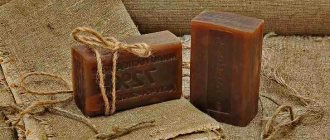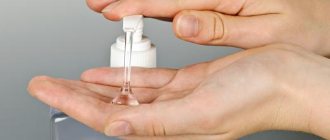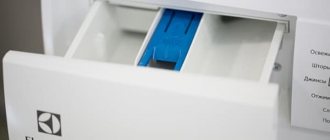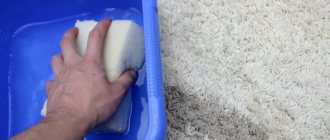Updated: 07/11/2021 16:13:31
Despite the fact that nowadays the choice of detergents and powders is very wide, many housewives prefer to use simple household products such as soda, vinegar, citric acid, etc. Soda has many advantages - it has excellent cleansing, deodorizing, disinfecting qualities, it is safe for the human body and costs almost a penny. These properties of soda allow you to get the desired result when cleaning and carrying out other activities, as well as save money on the family budget. One of the uses of soda is washing clothes. In this article, we will look at what can be washed with this product, how to do it correctly, and whether soda can be used in modern washing machines.
Properties and effectiveness of soda when washing clothes
This substance is used in washing for:
- Effective cleaning of clothes.
- Softening fabrics.
- Improves the color of colored items, lightly whitens white fabrics.
- Eliminates unpleasant odors, even persistent ones, such as sweat, cigarette smoke.
- Softening hard water (things wash very poorly in hard water).
- Disinfection of clothing, especially in cases where the use of specialized products may cause an allergic reaction. Soda prevents the development of pathogenic microflora, eliminates mold and many bacteria. If it is used for washing in an automatic or semi-automatic machine, then fungus will not appear in it and there will be no musty smell.
- Softening clothes (this property of soda makes it possible to replace fabric softener with it).
All the tasks posed to expensive washing powder are perfectly solved by soda. It is enough to use this product once to ensure its effectiveness. But it’s better not to just wash with soda, but to make a gel with additional ingredients such as laundry soap and essential oil of your choice (if family members do not have allergies). Read about this gel and the method of its manufacture at the end of the article.
Is your sewer pipe clogged?
Usually, pipes become clogged because hair, pieces of food and grease get into the drain, a dense plug is formed that interferes with the outflow of water, bacteria actively multiply in stagnant water and a characteristic musty smell appears. Removing a blockage is not difficult if you know how:
- You need to boil 3 liters of water and dissolve half a glass of sodium carbonate in it.
- Pour the resulting mixture down the drain (soda ash perfectly dissolves grease, soap residues and other organic substances).
- After 30-40 minutes, open the tap - running water will wash away the remaining cork and product.
Wash the floor
For this, 3 tbsp. l. sodium carbonate is diluted in a bucket of hot water. You need to wash the floor with this composition while wearing gloves; after wiping the floor with soda, you need to wash it again with clean water to wash off any remaining product. This composition can be used to wash: tiles, natural stone floors, linoleum.
Under no circumstances should you wash wooden or painted floors, varnished parquet, fiberglass tiles, or laminate floors with soda ash.
Is washing with baking soda safe?
Yes, baking soda can be used for laundry in most cases. It is not used only if the fabric is delicate and does not tolerate any, even the slightest, aggressive influence. These are things from:
- Wool and silk.
- Synthetic fabric.
- Membrane fabric.
- Impregnated fabrics.
- Leather and dermantine.
- Velvet.
- Suede.
- Velor.
- Rubberized fabrics.
Also, it should not be used to clean colored items that may fade. In other cases, soda can be used in its pure form, as part of homemade washing mixtures, as an additive to regular washing powder, for pre-soaking. It can be used both by hand and in the washing machine. Moreover, both regular baking soda and soda ash can be used.
If you think that soda ash is some kind of harmful chemical, then experts hasten to assure you that this is not so. This is regular dehydrated sodium bicarbonate (baking soda). To rid the substance of excess moisture, it is simply heated to 160 degrees. Dehydration is necessary to ensure that a lot of foam does not form during the manufacture and use of the detergent. At the same time, the soda itself becomes more active and effective, as the concentration of the active substance increases. You can buy soda ash at a hardware store or make it yourself by heating the food component in the oven to the desired temperature (160-200 degrees) on a baking sheet covered with parchment paper. Processing time is no more than an hour. This product should be stored in a tightly sealed bag or other container, as sodium carbonate easily absorbs water, forming a hydrate (turning back into baking soda).
It is interesting that Sodium carbonate is in first or second place (and therefore exceeds all other ingredients in quantity) in the composition of drugs from such well-known brands as Procter & Gamble, Amway. This component is added to detergents not only because of its effectiveness in cleaning things, but also because it prevents the formation of scale in the washing machine and reduces the degree of water hardness. And improves the connection of fat molecules with powder molecules. That is, in fact, when buying an expensive detergent, the consumer pays for dehydrated soda.
For reference, ordinary soda has an almost neutral acid-base balance (pH-8.1); it is widely used for cooking and for other household purposes, including to increase the efficiency of washing. Soda ash has a more alkaline reaction (pH-11); accordingly, its effectiveness during washing increases, but therefore it is not used in food production, exclusively for household and industrial work.
Eliminating unpleasant odors in an automatic machine
There are several reasons why a washing machine emits bad odors . The main problem is excessive accumulation of moisture and the formation of mold in places that are difficult to clean. Proper use of soda will allow you to carry out internal disinfection and eliminate odors.
The best results are achieved through regular cleaning. The procedure is repeated once every 2 months. In order to keep the unit clean, experts advise adding a pinch of soda to the detergent every time you wash it. This will make the water softer, and its effect on components and mechanisms less aggressive.
Clean the car like this:
prepare a mixture of equal parts of water and soda ash;- the composition is applied to the external parts - the drum, powder compartments, rubber gaskets, cuffs. This is where limescale and mold appear most quickly;
- let stand for half an hour;
- take a soft foam sponge and carefully process the machine parts;
- after external cleaning is completed, turn on the main wash mode at low temperatures. This will finally wash away the soda fragments.
The final stage is cleaning the drain filter. After the end of the washing program, remove the device and treat it with the same soda solution. Then they are washed under the tap and installed in place. Additionally, clean the filter connection area.
The video will show you how to clean a washing machine using soda:
Calcified or regular – what to choose
Which soda is best to use is up to the housewife to decide. It depends on the availability of a certain product at hand, the degree of contamination of things, and the composition of the fabrics. Regular food is in every person's kitchen, it is accessible. You need to look for calcined one, as it is not sold in all supermarkets and hardware stores. True, in our time of digital technology, it will not be difficult to order Sodium carbonate on a website on the Internet. Keep in mind that food grade food will do the job well if things are moderately dirty and the stains are not permanent. And calcined is a heavy weapon against difficult-to-remove contaminants - traces of fat, tea, coffee, grass, red wine, etc. And it can be used when strong whitening is required.
Application of the washing variety
Washing soda or household soda is a less aggressive calcined variety that can be added to the powder during washing if the items are stained or excessively soiled. You can use it to soften water. To do this, two tablespoons of the product, poured into the tray with the powder, are enough.
Using washing soda, you can effectively clean your washing machine to remove scale and other deposits - grease, soap residue, and mold. Although this substance is safer than the technical variety, it is recommended to protect your hands with gloves.
The cleansing process has a similar algorithm to technical soda. After diluting the product with water in a 1:1 ratio, distribute the resulting slurry on the internal surfaces. The holding time is increased to 35 minutes, after which a short washing program is started.
Another method is used, based on cleaning the machine with washing soda. Take a tablespoon of the product and 150 g of powdered citric acid. The components are mixed and placed in the powder compartment. The drum remains empty. The water heating temperature is set to the maximum level and the washing machine is turned on. The program is selected through all stages of washing, including rinsing.
Rules for safe use of soda during washing
Despite the fact that soda is a safe substance of natural origin, it must be used carefully. Take these precautions, especially when using more concentrated soda ash:
- Work only with gloves. If the substance comes into direct contact with the skin, irritation may occur and the skin may become very dry and cracked. To protect your hands, ordinary rubber gloves are suitable, in which housewives wash dishes and clean.
- Make sure that the substance does not get into your eyes or mucous membranes, otherwise unpleasant sensations cannot be avoided. If this happens, rinse the contact area with plenty of running water.
- Do not use the product to clean delicate fabrics, wool, fur, or down items.
- Do not wash dark, colored fabrics that may fade, especially at high temperatures.
- Do not exceed the dosage of the product, especially when using a calcined substance, otherwise it may adversely affect tissue fibers.
- The hotter the solution (especially calcined!), the more active the substance becomes. If the housewife washes with soda in cool water without any problems, then the same amount of components in hotter water can cause a chemical burn - this is another compelling argument in favor of observing dosages. If you buy soda ash in a store, there will be instructions on the package. Read it and stick to it.
You also need to follow the rules for storing dry soda. It is necessary that no water gets on the pack, otherwise the substance will cease to be free-flowing, will harden, and its properties may change.
Precautionary measures
Since this alternative to washing powder (soda ash) is a caustic alkali, precautions must be taken when working with it. It must be borne in mind that if it gets on the skin or mucous tissues, a burn may appear at this place.
When soda ash is mixed with water, the reaction becomes even more aggressive, so rubber gloves must be used when using this product. Contact must not be allowed:
- with mucous membranes;
- respiratory tract;
- derma.
Store in a tightly closed container and in a hard-to-reach, dry and cool place. From cardboard boxes you need to pour it into jars so that the soda does not crumble or get wet. After finishing work with it, it is advisable to ventilate the room.
The use of soda ash and plain soda depending on the desired effect
Sodium carbonate is used in this way and in the following quantities:
- To soften things (towels, bed linen, underwear, baby clothes and diapers), pour 50 grams of soda into the conditioner compartment (if you wash it in an automatic machine). Activate the extra rinse function. If it is hand wash, add 5 grams of the component for every 5 liters of water, soak the items for 20 minutes after washing, but before rinsing.
- To remove stubborn stains, mix 250 ml before washing. water, 40 ml. table vinegar in a consistency of 6% or 9%, 30 grams of Sodium carbonate. Wet the stain with the mixture, wait 15 minutes, and scrub with a brush.
- To remove stains from clothes of children under 5 years of age, take 2 liters of water, add one tablespoon each of soda and hydrogen peroxide. Soak for half an hour, rinse thoroughly.
You can add a few tablespoons of regular soda both when washing and when soaking and rinsing. With its help you can carry out wet and dry cleaning of things. Wet cleaning of things occurs using a paste of water and soda (you can add a teaspoon of vinegar or hydrogen peroxide). You need to apply the paste to the stain, rub it with a brush without strong pressure, leave for 20 minutes, and then rinse. If necessary, the procedure can be repeated 2-4 times. Dry cleaning is relevant when it is impossible to wash the item for some reason, but the stain (and unpleasant odor) needs to be removed. To do this, sprinkle soda on the stained area or apply a white cotton bag filled with this component to the stain. Wrap the item in a bag and leave it for half a day. Then unwrap the bag, brush off the powder, and hang the item to air for several hours.
Digestion
Boiling can whiten and disinfect things with old stains. It is often not worth using the method - the fabric quickly becomes unusable from such “strict” measures. For boiling, choose a large enamel pan, bucket or boiling pot; you can boil it in a galvanized steel container. Copper and aluminum containers, as well as pots with chipped enamel, are not suitable - stains will remain on the laundry.
- Soak the items in water, wring them out and rub them with laundry soap.
- Heat the water in the boil and add sodium carbonate at the rate of 250-500 g per 10 liters. Grate 250 g of laundry soap and add to the solution. The boiling time can be reduced by adding a couple of tablespoons of hydrogen peroxide or ammonia to the composition.
- When the soap has dissolved, put the laundry in the boiling water and boil for about two hours or 40-50 minutes if peroxide or ammonia is added. Gently turn things over periodically to ensure they are evenly soaked.
- Leave the laundry in the boiling water for 30-40 minutes after boiling, and then rinse well in a large volume of water.
Important! Do not boil colored linen, as well as items made of synthetics, silk and wool.
Colored laundry should not be boiled
Super soda-based laundry detergent
Domestic housewives have a recipe for an eco-friendly homemade preparation that copes well with most stains on clothes, linen and other fabric items. In any case, the product works no worse than store-bought powder or gel. The product's formulation contains no potentially harmful components that could cause an allergic reaction or otherwise harm human health or the environment.
The gel contains the following ingredients:
- Soda Ash
. As already mentioned, this is the main and absolutely safe component of purchased laundry detergents. During the first cleaning procedures, Sodium carbonate will release particles of accumulated chemical compounds present in industrial powders from fabric fibers.
- Regular laundry soap.
Previously, it was widely used for washing, now it is undeservedly forgotten, but, of course, it has not lost its effectiveness.
- Essential oil
, which will give things a delicate aroma. If you take a product with bactericidal properties, during washing the items, the interior space and the mechanism of the washing machine will be additionally disinfected. It can be tea tree oil, any coniferous oil. But even if you don't add essential oil, your clothes won't smell like laundry soap. After washing, one smell will remain - the aroma of cleanliness. Especially if you dry it outside.
The gel does not produce foam, but washes very well. However, you need to take into account that the same rule applies here as in the case of using pure soda - you cannot wash silk, linen, wool, or synthetic items with it. To do this, it is better to take baby shampoo or an alternative product.
Important Tips
Before you start washing, you need to familiarize yourself with the advice of professional laundresses:
- Things should be rinsed thoroughly. Otherwise, white streaks will remain on the fabric. Soda does not harm the material upon short-term contact, but if it remains in the fibers after washing, they will slowly deteriorate.
- When starting to wash, you need to take into account the information indicated on the product label.
- Baking soda can be used as a water softener.
- Do not rub a stain sprinkled with baking soda too hard, as the abrasive may damage the fabric.
- Baking powder is used for washing diapers, rompers, and vests. This food supplement will not provoke an allergic reaction in the child. Therefore, it is often used by mothers of babies suffering from diathesis.
Soda absorbs foreign odors well. It is enough to package the baking powder in fabric bags and place them in the pockets of the item that gives off unpleasant odors. After 2-3 days the smell should disappear.
You will find maximum useful information about washing clothes and various fabric products here.
The procedure for preparing washing gel based on soda
Preparing the gel is very simple, although the process takes some time, you get enough laundry detergent that it will last for several weeks:
- We take a grater, which we use in the kitchen for chopping food, and grate 100 grams or half a standard bar of ordinary laundry soap on it. We don’t worry about the grater, nothing will happen to it, just wash it to use it for its intended purpose in the future. If you don’t have a grater, grind the soap in any convenient way, for example, with a knife.
- Boil 3.5-4 liters. water (with more liquid, the gel will be more fluid). It is better that it is not tap water, as it may contain chlorine and other harmful additives.
- Pour soap shavings into boiling water and stir to dissolve quickly and evenly.
- Add the same amount of calcium bicarbonate to the soap solution as soap. That is approximately 100 gr. or 4 tbsp. l. Stir.
- Turn off the heat and wait for the product to cool completely and thicken. This will take several hours.
After the gel has cooled, pour it into storage containers. You can use a bottle from used liquid powder or liter plastic milk bottles.
One wash uses approximately 250 grams of soda-based gel. An increased amount of product does not in any way affect the integrity of the fabric structure, so there is no fear of exceeding the norm when loading a batch of laundry, but it is still better not to overdo it, since the effect will not change.
Benefits of laundry detergent made from soap and soda
This detergent has many advantages over industrially produced washing powders and even over regular soda:
- Natural composition and can be used for washing dishes and cleaning all surfaces in the kitchen, including windows and oven.
- The product is universal, suitable for use in different types of washing machines - automatic, semi-automatic. And for soaking, subsequent hand washing.
- You need to pour the gel into the compartment intended for powder or load the product directly into the drum on the items you are going to wash. That is, there are no complicated features in its application.
- Eco-gel washes out well. You can additionally use wine vinegar to rinse and soften clothes. Add 150-250 milliliters directly to the rinse aid compartment of the washing machine. Or carry out the rinsing procedure manually.
- Cheap but effective components.
- Removes heavy stains.
In conclusion, we can say that soda is really suitable for washing almost any clothes and fabrics. And soda ash is even better. A gel made from Sodium carbonate and laundry soap is useful not only for cleaning clothes, it can also replace almost any household chemical product.
How to soften hard water
Hard water damages household appliances, and it’s easier to wash in soft water. It is not difficult to soften water with laundry alkali; you cannot use it for cooking, but it is suitable for pouring into the iron and washing.
- Dissolve three tablespoons of powder in a bucket of water. Leave for half an hour to an hour.
- When a white sediment forms at the bottom, carefully drain the clean water and use it for laundry and other household purposes.
Helpful advice. You can soften water for drinking, cooking, or bathing with baking soda.
It is advisable to soften the water for machine washing, since scale, which forms at +60°C and above, clogs pipes and disables equipment. True, modern washing powders contain softeners, but for very hard water it is advisable to add a little washing soda or use Calgon.
Extremely soft water is good for washing - it reduces the consumption of detergents and removes dirt faster. However, excessive softness destroys metals and it is difficult to rinse things in it. Follow recommended dosages.
Soda can soften hard water, and things in the machine will be washed better











